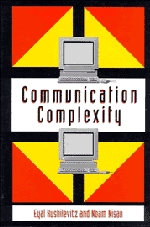Book contents
- Frontmatter
- Contents
- Preface
- I Two-Party Communication Complexity
- II Other Models of Communication
- III Applications
- 8 Networks, Communication, and VLSI
- 9 Decision Trees and Data Structures
- 10 Boolean Circuit Depth
- 11 More Boolean Circuit Lower Bounds
- 12 Time and Space
- 13 Randomness
- 14 Further Topics
- Index of Notation
- A Mathematical Background
- Answers to Selected Problems
- Bibliography
- Index
13 - Randomness
Published online by Cambridge University Press: 05 November 2009
- Frontmatter
- Contents
- Preface
- I Two-Party Communication Complexity
- II Other Models of Communication
- III Applications
- 8 Networks, Communication, and VLSI
- 9 Decision Trees and Data Structures
- 10 Boolean Circuit Depth
- 11 More Boolean Circuit Lower Bounds
- 12 Time and Space
- 13 Randomness
- 14 Further Topics
- Index of Notation
- A Mathematical Background
- Answers to Selected Problems
- Bibliography
- Index
Summary
In Chapter 3 we considered randomized communication complexity, where Alice and Bob are allowed to use randomness during the execution of protocols. In this chapter we apply various communication complexity measures and results to the study of randomness in other areas.
Quasirandom Graphs
Randomly chosen graphs have many nice properties. It is an interesting question whether we can construct a graph with some of the basic properties of random graphs. The following definition captures one family of such interesting properties.
Definition 13.1:Let G = (V, E) be a graph on N vertices. G is a k-quasirandom to within ε if, when choosing at random k vertices v1, …, vk from V, the induced subgraph H is distributed to within statistical distance of at most ε from the uniform distribution on the 2(½) k-vertex graphs (if vi = vj there is no edge connecting them).
The intuition is that if G was a truly random graph (that is, for every two vertices v1, v2 ∈ V the edge (v1, v2) is in E with probability 1/2), then each k vertex graph is equally likely to appear in G. It turns out that the distributional communication complexity of a certain function associated with the graph is closely related to its being quasirandom.
Definition 13.2:Let G be a graph on N = 2n vertices. The function EDGEG(x, y) on two n-bit strings x and y is defined to be 1 iff there is an edge between the vertices x and y in the graph G.
Information
- Type
- Chapter
- Information
- Communication Complexity , pp. 148 - 155Publisher: Cambridge University PressPrint publication year: 1996
